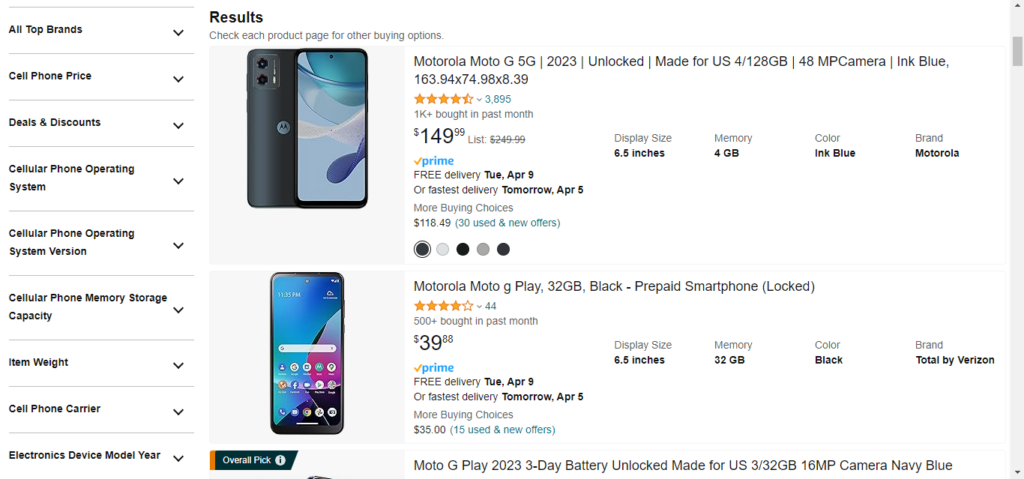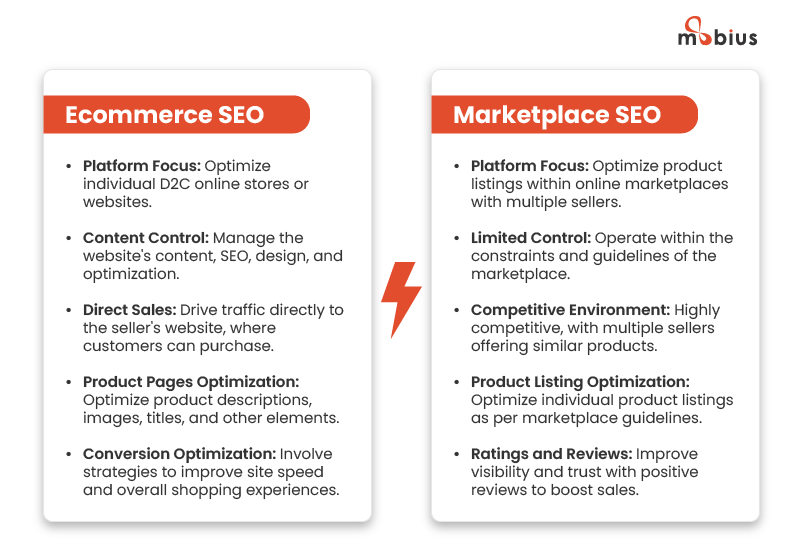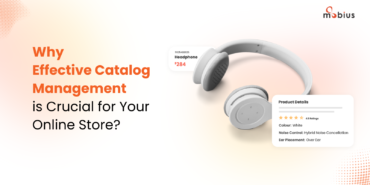SEO (Search Engine Optimization) is popularly connected with search engines like Google, Bing, Yahoo, etc. That’s what comes to mind when you hear SEO, but SEO is not limited to only traditional search engines. Ecommerce businesses with a solid online presence know the importance of search engine rankings in driving high-quality website visitors and conversions.
However, mere top SERP ranking doesn’t suffice in a competitive industry like ecommerce, and businesses should optimize their product listings on various ecommerce marketplaces. And here, your usual keyword SEO efforts aren’t enough.
Every ecommerce marketplace has a unique SEO algorithm. Although the basic rules of search engine optimization remain the same, the competition is tougher. As a result of multiple sellers trying to sell similar products, you need the right SEO strategies to rank at the top.
So, what is Marketplace SEO?
Marketplace SEO refers to the practice of optimizing product listings within online marketplaces to improve visibility and rank higher in search results.
Just like traditional SEO focuses on optimizing websites for search engines like Google, marketplace SEO is tailored specifically for platforms such as Amazon, eBay, Etsy, and others.
As mentioned above, these marketplaces have algorithms that perform searches upon keyword queries and display products based on customer buying behavior. In the case of traditional search engines, the aim is to fetch the most relevant pages on the query.
Let’s search for smartphones using the search engine Google. Here’s the result it shows:

When we search for the same product on the Amazon marketplace using just the keyword, it shows the search results for the top products according to the marketplace. And we didn’t even have to type a long-tail keyword.

Sometimes, people also confuse marketplace SEO with ecommerce SEO. So, let’s understand the difference.
How is SEO for marketplaces different from ecommerce SEO?
Ecommerce SEO and Marketplace SEO both focus on optimizing online platforms for better visibility in search engine results, but they target different types of platforms and have distinct strategies.

How to crack ecommerce marketplace SEO?
Cracking the code of marketplace SEO demands a nuanced approach, especially considering the exponential growth of online retail. According to Statista, revenue in the ecommerce market is forecasted to reach $3,178 billion this year and $4,997 billion in 2029. Imagine the opportunity you have to capitalize on and earn your market share.
Here are some key strategies to optimize product listings on online marketplaces like Amazon, eBay, Etsy, or Alibaba.
1. It all starts with keyword research
A thorough keyword research will identify the most suitable keywords for your products. Ensure you choose high to medium-volume keywords for optimization. As for tools, you can use Amazon’s Keyword Tool, Google Keyword Planner, or third-party tools to find keywords used by target customers for product searches. Lastly, don’t forget to include long-tail keywords, as they can be more specific to your products and have comparatively low competition.
A study by Ahrefs revealed that 47.37% of Amazon shoppers start their product searches on the platform itself.
2. Work on those product titles
Descriptive and keyword-infused product titles that accurately describe your product improve the chances of them appearing in top search results. Try to include brand name, key features, size, color, etc, while ensuring the title’s character limit adheres to the respective marketplace guidelines.
Research by Amazon suggests that products with titles exceeding 50 characters witness a decline in click-through rates.
3. Add details to your product descriptions
Customers can make confident purchases if they get accurate product information in detail on your pages. So, you must write detailed and compelling product descriptions that talk about the features, benefits, and USPs. Consequently, you get the opportunity to incorporate relevant keywords into your descriptions.
More than 80% of consumers perform thorough research before purchasing a product online.
Pro tip: Go for bulleted points or numbered lists instead of paragraphs to make key information easily understandable.
4. Don’t underestimate the impact of quality images
Present-day shoppers expect a seamless experience. Including high-res images shot from different angles makes it easier for the shopper to assess the suitability. Follow the marketplace’s image guidelines and use clear, professional-looking photos.
60% of shoppers say high-quality images influence their buying decisions.
Pro tip: Include images that accurately represent the size, color, and other important product attributes.
5. Reviews and ratings go a long way
Positive product reviews help shoppers determine the quality of your product and motivate their decision to purchase. Marketplace algorithms also consider the popularity of your products while generating the search results. Therefore, encourage your customers to write reviews.
98% of shoppers say reviews are essential in forming purchase decisions.
Pro tip: Monitor and analyze any issues raised by customers to maintain a positive reputation in the marketplace.
6. The key is to monitor performance and iterate consistently
Optimizing product listings for marketplace SEO is not a one-time process. You need to continuously monitor the performance, including ranking, click-rates, and sales. This regular analysis allows you to understand the results of your SEO efforts and helps make further adjustments.
Leveraging ecommerce marketplace SEO services for greater results
Cracking the code of ecommerce marketplace SEO requires a nuanced understanding of the unique algorithms and competitive environment of online platforms like Amazon, eBay, and Etsy. Unlike traditional SEO, marketplace SEO demands tailored strategies to optimize product listings within the constraints of each platform.
From keyword research and optimizing product titles to enhancing product descriptions and images, every detail matters in capturing the attention of potential customers and securing top rankings.
As it is an ongoing process that demands continuous monitoring and adjustment efforts, many businesses find it beneficial to outsource product listing creation and optimization. If you would like to explore the option, feel free to reach out to us and learn how our teams of SEO experts can help you successfully crack the marketplace SEO game and drive your business.






